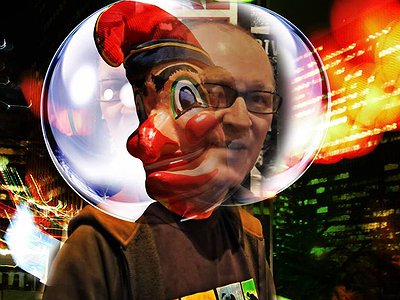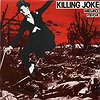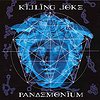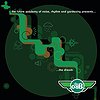Name: Mike Coles
Nationality: British
Occupation: Graphic Designer
Recommendations: Mikhail Bulgakov: The Master and Margarita;
Cannonball Adderly/Miles Davis: Somethin’ Else
Contact/Website: If you enjoyed this interview with Mike Coles of Malicious Damage, examples of his work can be found on the Malicious Damage website and his personal faceboom page.
When did you start creating designs and layouts for music - and what or who were your early passions and influences? What what is about the relationship between music and design that drew you to it?
I used to do it at school back in the sixties. In those days singles came in the generic record label bag and I used to buy plain cardboard ones and draw on them. I remember doing Pink Floyd’s "Arnold Layne" and "See Emily Play", but can’t remember any others. In my teens I was influenced a lot by the West Coast hippie graphics plus the OZ and IT stuff, Martin Sharp and Hapshash and the Coloured Coat. I’ve been a music freak since watching Lonnie Donegal on TV when I was around 6 or 7, but have never played an instrument, apart from a futile attempt at guitar in my late teens. Art and visual stuff were my forte, so I stuck with that. At first I just used to draw purely for the sake of it, the music connection grew gradually later.
For most artists, originality is first preceded by a phase of learning and, often, emulating others. What was this like for you? How would you describe your own development as an artist and the transition towards your own voice? What is the the relationship between copying, learning and your own creativity?
I’ve always copied stuff, going back to Aubrey Beardsley in my early teens, hippie stuff in my late teens/early twenties, John Heartfield, George Grosz, Francis Bacon, Russian Constructivists, Gilbert & George and Tadanori Yokoo later on. I’m still heavily influenced by what I see around my and I’m not ashamed to take influence and adapt/corrupt to my own style. If I see something I like I often wonder what would happen if I tried something like that, so I have go.
What were your main design-challenges in the beginning and how have they changed over time?
When I first came to London in 1976 the main challenge was getting any sort of work at all. With no training or secondary education I was never going to get any design work, so I mainly worked in production - finished artwork and paste-up for print in advertising agencies. I was still doing my own stuff but there was nowhere to aim it until I met with Killing Joke, and we started our own label, Malicious Damage, with a few mates. After that I had free reign for a few years, working directly with the bands who were really responsive and respectful of what I was doing. But then the major labels and suits started taking over and I subsequently dropped back into the advertising world to try and earn some money and start a family. These days I’m back to working closely with the musicians, most of whom are close friends so we have a natural rapport and people are happy to leave us to it.
What makes for a great music related design? What are the differences in terms of approach for different formats like posters, flyers and covers?
What kind of relationship is there between the cover of a release and the music? What can the visual layer add to the music or how can it even change its impact? Would you say the end result is an art work in its own right, a fusion or merely a support of the music?
It’s all about the music, the design is just packaging, an embellishment. All the classic album covers are nothing on their own, without their association with the music. Nice images maybe, but that’s all, whereas the music will always have the power.
How do you make use of technology? In terms of the feedback mechanism between technology and creativity, what do humans excel at, what do machines excel at?
Technology is just a tool, like a pencil or a paintbrush. Without the human input and emotion it’s nothing.
Collaborations can take on many forms. What role do they play in your approach and what are your preferred ways of engaging with the artists you're working for?
It can vary from a full on battle/confrontation to a pleasant game of ping pong, batting the ideas backwards and forwards. Working with Killing Joke can be the former, The Orb can be the latter. I’m more of an artist than a designer, so unfortunately I tend to try and please myself more than the client, hence I’ve never survived in the corporate world. With Killing Joke these days we know each other so well that things just seem to happen without too much friction or heartache. I suppose we’re growing up.
Could you take us through a day in your life, from a possible morning routine through to your work? Do you have a fixed schedule? How do music and other aspects of your life feed back into each other - do you separate them or instead try to make them blend seamlessly?
Get up, get dressed, do toilet, drink tea, eat toast. That’s the initial ritual. At the moment I’m working on designing a pack of playing cards, writing mercenary rhymes to go with each image and planning an exhibition and audio/video experience to accompany everything. So after tea and toast I’ll head upstairs to my studio, the skyline zone, where I’ll go through the 56 images and rhymes and wonder how to improve/amend them. Are they twisted enough? Are they funny enough? Are they too disturbing? Sometimes I read the rhymes aloud in weird voices. All the images are printed out and put into a scrap book that I’ll then scribble notes and changes on later. I lost my wife to cancer earlier this year and at some point each day I’ll break down in tears for anything from a few minutes to an hour or so. This also charges me up creatively.
Could you describe your creative process on the basis of a piece or album that's particularly dear to you, please? Where did the ideas come from, how were they transformed in your mind, what did you start with and how do you refine these beginnings into the finished work of art?
With the Killing Joke Wardance cover I wanted to have the horrors of war compared to the banality of life. At first it was a male ballet dancer dancing over the corpses. That gave us the war, the dance and the killing, but no “joke”. Then I saw the poster for the film “Top Hat”, photocopied it and replaced the ballet dancer with Fred Astaire. It worked perfectly, and everybody loved it.
There are many descriptions of the ideal state of mind for being creative. What is it like for you? What supports this ideal state of mind and what are distractions? Are there strategies to enter into this state more easily?
With me it’s constant creativity. I’m always mentally looking at and storing images and ideas in the back of my mind, watching, recording, borrowing, stealing. When I eventually sit down to design and create I’m just pulling stuff I’ve already conceived out of my mental archives.
Do you tend to listen to the music in question a lot or at all while working on the project? Is your approach more guided by the emotions or ideas stirred by the music or conceptual considerations?
The music is very important, along with anything the musicians have said to me in association. I listen a lot when I’m working on the project. So much so, that I’m usually sick to death of it by the time it’s released.
What kind of materials have proven to be particularly effective to work with? Do you maintain an archive of materials for potential use in future projects? If so, what does it consist of and what are your criteria for adding something to it?
I work a lot with photography and collage, digital and physical. I have boxes of old magazines that I’ve collected over the last 40 years, plus boxes of photos from from the pre-digital age, plus hard drives full of digital images. Fifties advertising always interests me, as do masks and faces. I spend a lot of time in museums photographing masks, statues and old sculptures.
Art can be a purpose in its own right, but it can also directly feed back into everyday life, take on a social and political role and lead to more engagement. Can you describe your approach to art and being an artist?
My art is a part of me and my everyday life, I’m constantly looking at things and re-interpreting them in my head, taking photos, making mental notes. I might be looking at people and imagining what one person would look like with another person’s head, what a building might look like if it was half demolished.
It is remarkable, in a way, that we have arrived in the 21st century with the basic concept of music design still intact. Do you have a vision of it, an idea of what it could be beyond its current form?
It’s still packaging for a product. I don’t take too much notice these days of the mainstream, I find it all a bit bland. Video and live visuals seem more relevant to the music than print, as so much is now delivered direct to devices rather than packaged in a printed sleeve. I’ve really enjoyed doing live visuals with bands and musicians.




